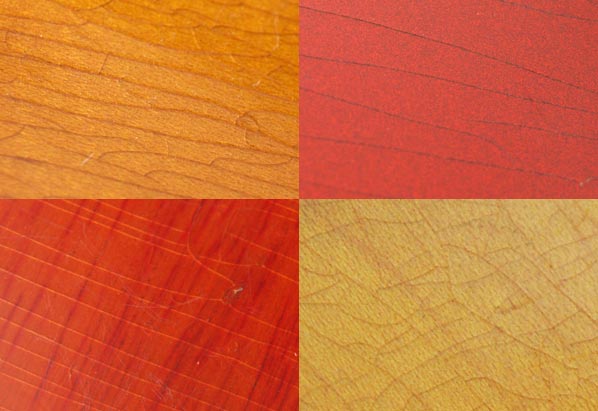How To Repair Missing Finish On Guitar

This is a term that is widely used in vintage guitar circles, but it'south meaning may not be immediately obvious. Finish checking, or weather checking every bit it is also known, refers to the blueprint of small cracks, usually comprising a series of parallel lines, but sometimes loosely checky, that tin can appear on certain guitars with nitrocellulose finishes. The cracks may exist loosely spaced or very tight, and can appear on whatsoever part of the guitar.
But what causes the checking? Every bit the 2 names suggest, these cracks are in the finish (paint) of the guitar and are caused by farthermost changes in temperature. Typically a guitar that has got common cold and then warmed too apace: maybe travelling in a cold vehicle, then brought into a warm venue – or flown in an unheated aircraft agree earlier landing in a warm destination. Merely this does non hateful guitars should not travel, merely that they must be immune to acclimatize gradually.
Finish 'checking' may actually be in lines rather than checks Figure i checking in a translucent Scarlet Gibson SG, Figure 2 in the Candy Apple tree Red of a Gibson Tune Maker
So how do y'all preclude finish checking?
Guitars volition typically travel in hard cases – this naturally protects the musical instrument from knocks and breakages, but will also protect from sunlight and temperature swings. If an instrument has spent some time travelling in cold weather it will ultimately get as cold as it's environment. The bug occur when the guitar is apace brought indoors – perhaps into a hot gild, under hotter stage lights. The rapid change in temperature causing the finish to cleft; effectively the wood expands more quickly than the stop. And then preventing these changes are as elementary as waiting for some time before removing guitars from their hardcases, and allowing expansion to occur slowly.
Figures three – five – in many guitars the checking resemble a mosaic of irregular shapes
Tin can it be reversed?
Terminate checking can not exist reversed, but it can be prevented – see Gibson'south recommended procedure for stop care below. Manifestly your guitar could be refinished, however this is expensive (see What is the Toll of the Refinishing a Guitar), only, in our opinion at least, unnecessary; finish checking tin exist considered as the 'patina' of a well loved and well used instrument. The majority of older guitars seem to have some level of checking, especially in countries with a range of climatic conditions. In fact the lack of this checking tin can be an indicator of a non-original end!
Gibson describe the problem of terminate checking in their owner's manuals every bit follows:
Abnormal Winter Exposure
Try to keep your guitar at room temperature. If y'all can't or if it gets left in the torso of a car for many hours or days, you run the risk of damaging the Gibson through stop checking.
1. Bring the instrument into a warm room. If you don't need it right away just let it warm up safely in it's ain case.
2. Utilize additional caution when a thoroughly chilled instrument is needed immediately:
A. Open up example lid about 1 inch allowing warm air to enter slowly.
B. Open lid 4-6 inches fanning out cold air until no condensation appears.
C. Open case hat fully and lift guitar approximately i inch from back of case. This allows warm air to broadcast in dorsum of the instrument in pocket-size amounts.
D. Work instrument upward and down in it'due south case to expel all the common cold air and admit the warm. If no condensation or haze appears, the musical instrument is ready to remove from the case. It volition all the same feel cold to the touch, just is past the danger bespeak of causing damage.
Eastward. Get out the case open up and so information technology too, can warm up thoroughly.
Follow these instructions and you can't become too far wrong!
What is the toll of refinishing a guitar
Source: https://www.guitarfact.com/finish-checking-guitar
Posted by: espinozaevinly89.blogspot.com


0 Response to "How To Repair Missing Finish On Guitar"
Post a Comment